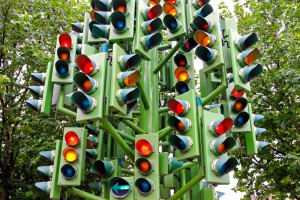Traffic Signal Malfunctions

Traffic signals are a normal part of our busy lives. Red means stop, green means go, yellow means slow down and prepare to stop – it all seems simple, but traffic signals are actually more complicated than most drivers might expect. Traffic signals at intersections are more than just three colored lights: They’re connected to a vast network of power cables and computers that control the cycle of reds, greens, and yellows. That cycle, itself, is the end result of countless hours of coordination and urban planning.
At its simplest form – in, for example, a town with only one or two stop lights – the cycle of traffic lights is divided between the two sides of the intersection so that the street with the most traffic gets a larger share of time to cross the intersection. Within each cycle period, there is time for cars to drive through on a green light, time for the yellow light to get them to slow down, and then a few seconds of “lost” time where every light is red to allow the intersection to clear before the sequence is repeated on the cross street. The lost time in each cycle (between the start of the red light and when traffic finally gets moving with the green light) must be balanced with the queues of cars that would build up if the cycle times were increased as well as with the wasted time each driver would experience while sitting for long minutes at a red light.
This basic pattern gets more complicated as more traffic signals are added to the area, since, ideally, cars that stop at one light should then be able to travel through several lights in succession before having to stop again. When coordinating several main streets and cross streets in a busy city, signal progression can become extremely complicated and usually requires a computer to plan the ideal cycles for each intersection.
All of this helps us understand that when traffic signals malfunction, traffic accidents are almost inevitable. Because drivers have been trained to trust the traffic signals, even a glitch of a few seconds could be disastrous. If, for example, a signal turned too quickly to green after a red light, a driver could enter the intersection while the cross traffic was still trying to sneak in one more car. So, too, if the signal progression isn’t retimed with the addition of each new traffic signal, unusual congestion could result, leading to frustration, high tempers, and atypically reckless driving.
If you have been injured in an accident and you suspect that a faulty traffic signal was involved, personal injury attorney of Duce Bastian Peterson has the experience to help you. Contact us today for a free consultation.
